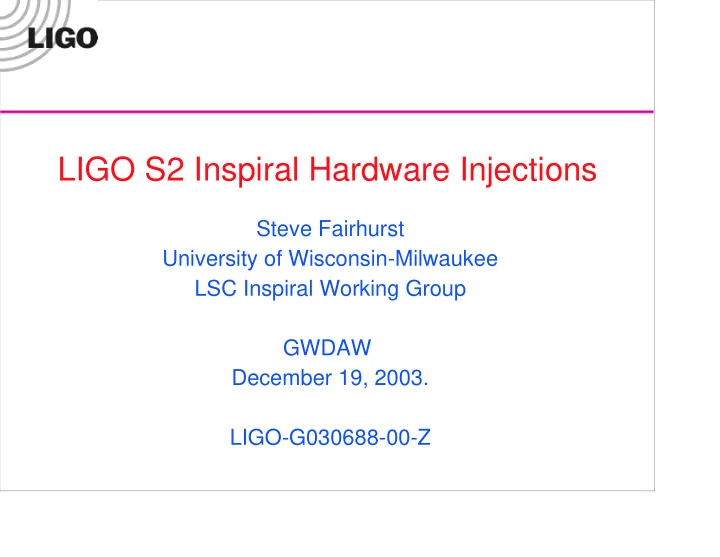

LIGO S2 Inspiral Hardware Injections Steve Fairhurst University of Wisconsin-Milwaukee LSC Inspiral Working Group GWDAW December 19, 2003. LIGO-G030688-00-Z
Introduction • Hardware injections provide a good test of the entire analysis pipeline. • Injection waveforms are generated as follows: » The inspiral waveforms h(t) are known, and have well defined frequency. » Given a transfer function, T(f), construct the signal v(t) to inject: f 2 T f L v t =T f t � h t where � � 2 C f 0 » L = arm length (m), C = calibration (m/count), f 0 = pendulum freq. » Ignore pendulum damping, digital filters. » Codes in LAL exist to do this. (T. Creighton)
Recovering the injections • AS_Q data recorded in counts. • This is converted to h(f) using response function R(f). • The response function varies in time and is given by: 1 � � t � t R 0 f � 1 C 0 f R f � � t C 0 » R 0 and C 0 (sensing function) measured at the start of the run. » Calibration updated every minute with � and � coefficients. • The inspiral code generates calibrated h(f). (Brown) » One calibration used for each 2048second data chunk. » This is match filtered against the inspiral template waveforms. » Triggers correspond to times when SNR is above threshold and � 2 below threshold.
S2 Hardware Injections • Set of 18 inspiral events injected at various times throughout S2, masses from 1.0, 1.0 to 10, 20 M SUN ; distances from 15 to 500 kpc. • Focus here on March 25 (2 sets) and April 10; 1.4, 1.4 and 1.0, 1.0 solar mass inspirals. • Results » Inspiral pipeline produces triggers in all 3 interferometers. » Triggers detected at expected time; time agrees (to one sample point) for all 3 instruments. » Measured distances are within 25% of injected distances. » Similar results for more massive injections using GEO pipeline (Babak).
Testing the Pipeline H1 triggers Many triggers • produced at times of hardware injections. Only a fraction • survive coincidence between L1 and H1. Loudest surviving • triggers have masses matching injection.
Timing Accuracy From here on, use only • templates matching injection parameters. Injections performed • simultaneously in all three interferometers. Trigger times agree to » within 0.25 msec. This is equivalent to one » sample point at a rate of 4096 Hz.
Variation of SNR with � The value of � was • varied between 0.4 and 1.4. Expect that: • SNR varies quadratically » with calibration, � � SNR maximized for » correct value of � . SNR is close to • maximum for both H1 and L1.
Variation of distance with � Distance varies linearly • with � , as expected. The actual calibration • gives a good measure of the distance.
Distance Measurements – L1 Inspiral code uses the • calibration at the start of the 2048 sec chunk. » Test how calibration varies over chunk. » Use calibration from start of every segment (128 sec). Distances in L1 are • accurate to within 15%. Varying time of calibration » does not affect distances by more than 2%. Will calibrate the data » every 128 sec.
Distance Measurements – H1 Distances in H1 are • accurate within 25%. Up to 10% change in • distance by varying calibration time. Calibrating at time closer » to the injection does not improve results. Will average the » calibration over 2048 second chunk.
Ending the Injection Recorded • excitation in agreement with expectation. Sudden end of • injection leads to low frequency excitation of AS_Q.
AS_Q excitations Excitation not seen in software injections. •
Conclusions • Hardware injections are a useful method of testing the entire analysis pipeline. » The hardware injections are “found” by the pipeline. » They provide confidence in our ability to use coincidence between detectors --- inspiral observed within 1 sample point at different detectors. » They provide an independent test of the calibration – SNR is close to maximum in both L1 and H1. – for L1 the distances are correct within 15% – for H1 the distances are correct within 25%. • We must treat the end of the inspiral more carefully. » Is being implemented in S3.
Recommend
More recommend